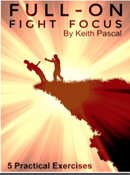Awareness and Intuition for Self-Defense
Awareness and Intuition for Self-Defense … First Steps
by Keith Pascal
A few weeks ago, I received the following letter:
Could you comment on how you ‘focus’ as you pass through the world?
For example, I’ve noticed in certain situations I
don’t know where to look! Like when exiting an
elevator into a corridor, do you look where you
are turning, or would you glance at what
might be behind you?
Do you simply slow your pace and try to absorb both?
If you have any previous articles on awareness and intuition I’d love to hear what you have to say!
— Robert
First of all, I don’t want to reinvent the wheel. If you want to explore developing your intuition in terms of safety, then I highly recommend that you read Gavin DeBecker’s book, “The Gift of Fear.”
DeBecker talks about getting in touch with your “hinky feelings.” This is oh, so important.
For how to lead a life of safety and awareness, I’d like to humbly recommend that you read my quick-to-digest story, “Tiptoeing to Tranquility: The Parable for FInding Safety and Comfort in Dangerous Times.”
I apologize for the seemingly blatant plug, but it really does talk about scanning perimeters, picking out safe zones, seeing danger at the edge of a parking lot, and a lot more. It’s available both in soft cover and as an ebook ($3.99), from Amazon.
Let’s talk awareness….
Note: Someday, I’d love to journal some of my
awareness building ideas and exercises into
an ebook. Someday. I feel that there is a lot
that hasn’t been said on the subject.
One of the first keys to being aware is “wanting” to be aware. In other words, you’ll be more aware if you think about being more aware. (This is one of those “nice” natural consequences.)
Robert mentions that he doesn’t know where to look in certain situations. My advice would be to make a list of some of those potential situations … elevators, behind countertops and bars, bathroom stalls, stairwell entrances in parking garages, and so on.
Then decide in each situation:
a) Do you want to be close to the source of the problem?
You can be more easily surprised, but you can also
more easily startle someone else, too.
b) Do you want a buffer of space between you and
the potential surprise danger? This gives you
more time to react.
Think of the above choices in terms of walking around a corner of a building. If you hug the wall, you could be surprised as you round the bend … but you could also surprise someone trying to surprise you.
On the other hand, if you walk closer to the curb, as you turn the corner, there is more time for you to respond to someone lying in wait.
We could keep going … a book’s worth, actually … but this is a start. Read the recommended books, and “decide” to be more aware.
Two last thoughts …
Knowing that I had written more about awareness, I googled “Keith Pascal” and “awareness.”
There were 929 results. 🙂
Finally, there is a bigger lesson to be learned when I say, “Sit with your back to the wall, facing the door.”


